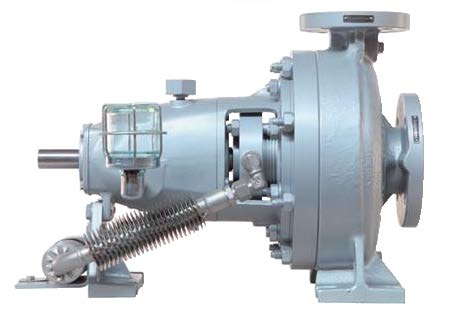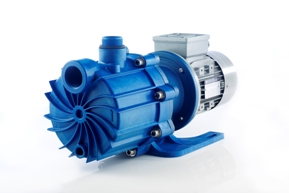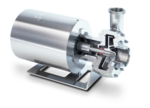We use cookies to help us deliver and improve this site. By clicking Confirm or by continuing to use the site, you agree to our use of cookies. For more information see our Cookie Policy.
Centrifugal pumps - Useful Information
What is a centrifugal pump?
A centrifugal pump is a mechanical device designed to move a fluid by means of the transfer of rotational energy from one or more driven rotors, called impellers.
Fluid enters the rapidly rotating impeller along its axis and is cast out by centrifugal force along its circumference through the impeller’s vane tips.
The action of the impeller increases the fluid’s velocity and pressure and also directs it towards the pump outlet. The pump casing is specially designed to constrict the fluid from the pump inlet, direct it into the impeller, and then slow and control the fluid before discharge.
How does a centrifugal pump work?
The impeller is the key component of a centrifugal pump. It consists of a series of curved vanes. These are normally sandwiched between two discs (an enclosed impeller). For fluids with entrained solids, an open or semi-open impeller (backed by a single disc) is preferred (Figure 1).
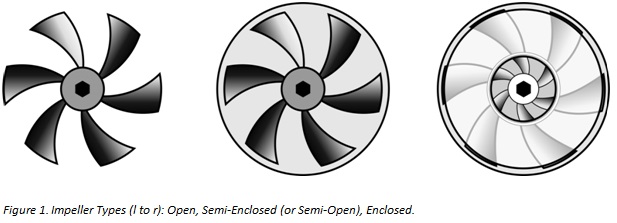
Fluid enters the impeller at its axis (the ‘eye’) and exits along the circumference between the vanes. The impeller, on the opposite side to the eye, is connected through a drive shaft to a motor and rotated at high speed (typically 500-5000rpm). The rotational motion of the impeller accelerates the fluid out through the impeller vanes into the pump casing.
There are two basic designs of pump casing: volute and diffuser. The purpose in both designs is to translate the fluid flow into a controlled discharge at pressure.
In a volute casing, the impeller is offset, effectively creating a curved funnel with an increasing cross-sectional area towards the pump outlet. This design causes the fluid pressure to increase towards the outlet (Figure 2).
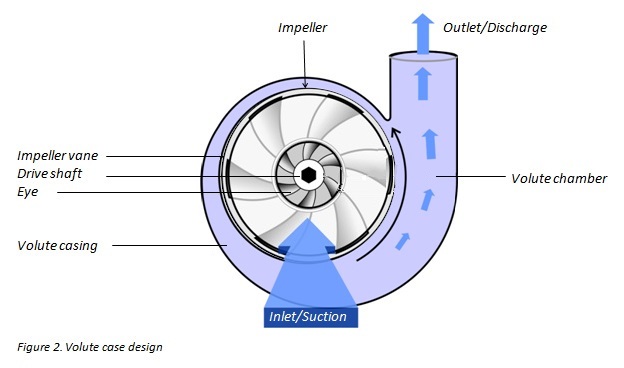
The same basic principle applies to diffuser designs.
In this case, the fluid pressure increases as fluid is expelled between a set of stationary vanes surrounding the impeller (Figure 3).
Diffuser designs can be tailored for specific applications and can therefore be more efficient. Volute cases are better suited to applications involving entrained solids or high viscosity fluids, when it is advantageous to avoid the added constrictions of diffuser vanes.
The asymmetry of the volute design can result in greater wear on the impeller and drive shaft.
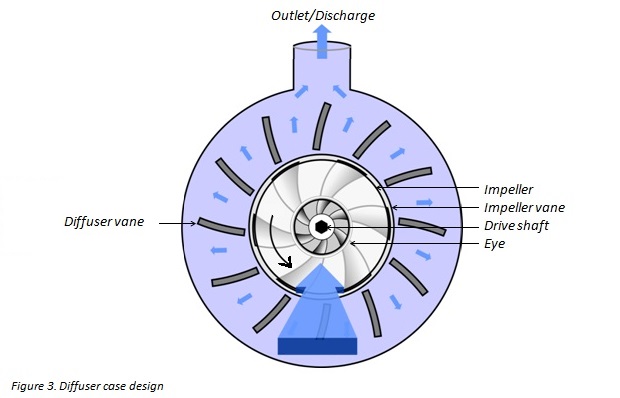
What are the main features of a centrifugal pump?
There are two main families of pumps: centrifugal and positive displacement pumps. In comparison to the latter, centrifugal pumps are usually specified for higher flows and for pumping lower viscosity liquids, down to 0.1 cP. In some chemical plants, 90% of the pumps in use will be centrifugal pumps. However, there are a number of applications for which positive displacement pumps are preferred.
What are the limitations of a centrifugal pump?
The efficient operation of a centrifugal pump relies on the constant, high speed rotation of its impeller. With high viscosity feeds, centrifugal pumps become increasingly inefficient: there is greater resistance and a higher pressure is needed to maintain a specific flow rate. In general, centrifugal pumps are therefore suited to low pressure, high capacity, pumping applications of liquids with viscosities between 0.1 and 200 cP.
Slurries such as mud, or high viscosity oils can cause excessive wear and overheating, leading to damage and premature failures. Positive displacement pumps often operate at considerably lower speeds and are less prone to these problems.
Any pumped medium that is sensitive to shearing (the separation of emulsions, slurries or biological liquids) can also be damaged by the high speed of a centrifugal pump’s impeller. In such cases, the lower speed of a positive displacement pump is preferred.
A further limitation is that, unlike a positive displacement pump, a centrifugal pump cannot provide suction when dry: it must initially be primed with the pumped fluid. Centrifugal pumps are therefore not suited to any application where the supply is intermittent. Additionally, if the feed pressure is variable, a centrifugal pump produces a variable flow; a positive displacement pump is insensitive to changing pressures and will provide a constant output. So, in applications where accurate dosing is required, a positive displacement pump is preferred.
The following table summarises the differences between centrifugal and positive displacement pumps.
Pump Comparison: Centrifugal vs Positive Displacement
| Property | Centrifugal | Positive Displacement |
| Effective Viscosity Range | Efficiency decreases with increasing viscosity (max. 200 Cp) | Efficiency increases with increasing viscosity |
| Pressure tolerance | Flow varies with changing pressure | Flow insensitive to changing pressure |
| Efficiency decreases at both higher and lower pressures | Efficiency increases with increasing pressure | |
| Priming | Required | Not required |
| Flow (at constant pressure) | Constant | Pulsing |
| Shearing (separation of emulsions, slurries, biological fluids, food stuffs) | High speed damages shear-sensitive mediums | Low internal velocity. Ideal for pumping shear sensitive fluids |
What are the main applications for centrifugal pumps?
Centrifugal pumps are commonly used for pumping water, solvents, organics, oils, acids, bases and any ‘thin’ liquids in both industrial, agricultural and domestic applications. In fact, there is a design of centrifugal pump suitable for virtually any application involving low viscosity fluids.
| Type of centrifugal pump | Application | Features |
| Canned motor pump | Hydrocarbons, chemicals where any leakage is not permitted | Sealless; impeller directly attached to the motor rotor; wetted parts contained in can |
| Magnetic drive pump | Sealless; impeller driven by close coupled magnets | |
| Chopper/grinder pump | Waste water in industrial, chemical and food processing/ sewage | Impeller fitted with grinding teeth to chop solids |
| Circulator pump | Heating, ventilation and air conditioning | Inline compact design |
| Multistage pump | High pressure applications | Multiple impellers for increased discharge pressures |
| Cryogenic pump | Liquid natural gas, coolants | Special construction materials to tolerate low temperatures |
| Trash pump | Draining mines, pits, construction sites | Designed to pump water containing solid debris |
| Slurry pump | Mining, mineral processing, industrial slurries | Designed to handle and withstand highly abrasive slurries |
Summary
A centrifugal pump operates through the transfer of rotational energy from one or more driven rotors, called impellers. The action of the impeller increases the fluid’s velocity and pressure and directs it towards the pump outlet. With its simple design, the centrifugal pump is well understood and easy to operate and maintain.
Centrifugal pump designs offer simple and low-cost solutions to most low pressure, high capacity pumping applications involving low viscosity fluids such as water, solvents, chemicals and light oils.
Typical applications involve:-
- Water supply and circulation
- Irrigation systems
- Transfer of chemicals in petrochemical plants.
Positive displacement pumps are preferred for applications involving highly viscous fluids such as thick oils and slurries, especially at high pressures, for complex feeds such as emulsions, foodstuffs or biological fluids, and when accurate dosing is required.
See our full range of centrifugal pumps |
|---|
General information |
Send us your enquiry |
Contact us |

